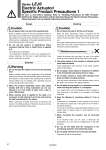
12-e595-motorless 49 / 81
10秒後にBOOKのページに移動します
Design Handling Caution Caution 1. Do not apply a load in excess of the operating limit. Select a suitable actuator by load and allowable moment. If the product is used outside of the operating limit, the eccentric load applied to the guide will be excessive and have adverse effects such as creating play on the guide, degrading accuracy and shortening the life of the product. 2. Do not use the product in applications where excessive external force or impact force is applied to it. The product can be damaged. The components including the motor are manufactured to precise tolerances. So that even a slight deformation may cause a malfunction or seizure. Warning Selection 1. Do not increase the speed in excess of the operating limit. Select a suitable actuator by the relationship of the allowable work load and speed, and the allowable speed of each stroke. If the product is used outside of the operating limit, it will have adverse effects such as creating noise, degrading accuracy and shortening the life of the product. 2. When the product repeatedly cycles with partial strokes (100 mm or less), lubrication can run out. Operate it at a full stroke at least once a day or every 1000 strokes. 3. When external force is applied to the table, it is necessary to add external force to the work load as the total carried load for the sizing. When a cable duct or flexible moving tube is attached to the actuator, the sliding resistance of the table increases and may lead to operational failure of the product. 1. Do not allow the table to hit the end of stroke. When the driver parameters, origin or programs are set incorrectly, the table may collide against the stroke end of the actuator during operation. Please check these points before use. If the table collides against the stroke end of the actuator, the guide, ball screw, belt or internal stopper can be broken. This may lead to abnormal operation. Handle the actuator with care when it is used in the vertical direction as the workpiece will fall freely from its own weight. 2. The actual speed of this actuator is affected by the work load and stroke. Check specifications with reference to the model selection section of the catalog. 3. Do not apply a load, impact or resistance in addition to the transferred load during return to origin. 4. Do not dent, scratch or cause other damage to the body and table mounting surfaces. This may cause unevenness in the mounting surface, play in the guide or an increase in the sliding resistance. 5. Do not apply strong impact or an excessive moment while mounting the product or a workpiece. If an external force over the allowable moment is applied, it may cause play in the guide or an increase in the sliding resistance. 6. Keep the flatness of mounting surface 0.1 mm or less. Unevenness of a workpiece or base mounted on the body of the product may cause play in the guide and an increase in the sliding resistance. In the case of overhang mounting (excluding cantilever), use a support plate or support guide to avoid deflection of the actuator body. 7. When mounting the actuator, use all mounting holes. If all mounting holes are not used, it influences the specifications, e.g., the amount of displacement of the table increases. 8. Do not hit the table with the workpiece in the positioning operation and positioning range. 9. Do not apply external force to the dust seal band. Particularly during the transportation. Series LEJS Electric Actuator/ Specific Product Precautions 1 Be sure to read before handling. Refer to “Handling Precautions for SMC Products” (M-E03-3) for Safety Instructions and the Operation Manual for Electric Actuator Precautions. Please download it via our website, http://www.smcworld.com 47